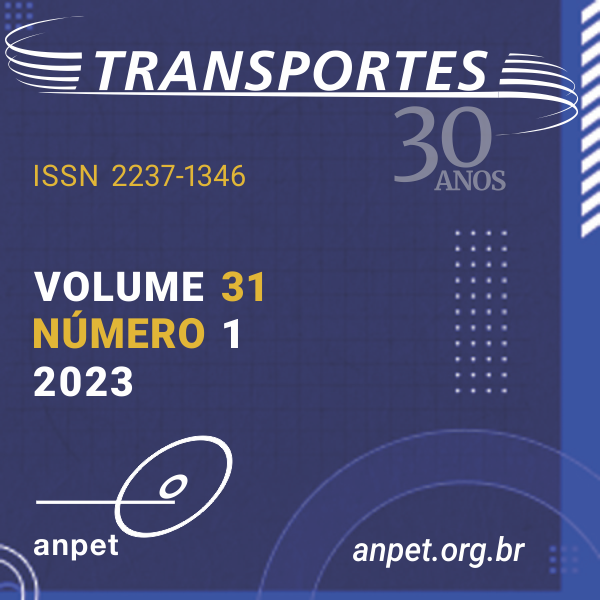Capacidade da inspeção de segurança durante a recuperação da COVID-19: estudo de simulação de um aeroporto doméstico no Brasil
DOI:
https://doi.org/10.58922/transportes.v31i1.2847Palavras-chave:
COVID-19, Distanciamento Social, Modelo de simulação, Projeto aeroportuárioResumo
Com a recente pandemia de COVID-19, o setor aéreo sofreu uma dramática crise operacional, na qual a quarentena e o distanciamento social repentinamente se tornaram habituais. Quando tais medidas são tomadas, a capacidade do aeroporto é reduzida, algo não previsto nas diretrizes de projeto. Esta pesquisa reconhece que o distanciamento social pode ser um fator importante no futuro dos terminais e apresenta uma contribuição metodológica baseada em simulação. A área de filas da inspeção de segurança foi avaliada sob diferentes combinações de %PHP (% de passageiros no horário de pico). Os resultados indicam que a área de filas existente não pode suprir o volume de passageiros pré-pandemia sob os procedimentos de distanciamento, mas a taxa de recuperação foi baixa o suficiente para permitir o distanciamento social na janela de tempo mais crítica. A metodologia contribui para uma abordagem mais resiliente em relação a potenciais eventos disruptivos no futuro.
Downloads
Referências
Abate, M., Christidis, P. and Purwanto, A. J. (2020). Government support to airlines in the aftermath of the COVID-19 pandemic. Journal of Air Transport Management, v. 89, p. 101931. DOI: 10.1016/j.jairtraman.2020.101931. DOI: https://doi.org/10.1016/j.jairtraman.2020.101931
ABC News (2022). Hong Kong relaxes incoming traveller COVID-19 restrictions, dropping hotel quarantine. Available at: <https://www.abc.net.au/news/2022-09-23/hong-kong-relaxes-incoming-traveller-covid-19-restrictions/101470492>. (Accessed: 21 February 2023).
ANAC (2010). Air Transport Yearbook, Brasília: Agência Nacional de Aviação Civil.
ANAC (2020a). Brazilian Civil Aviation Agency. VRA (actual flights). Available at: <https://sas.anac.gov.br/sas/bav/view/frmConsultaVRA>. (Accessed: 21 February 2023).
ANAC (2020b). Declaration of Capacity. National Civil Aviation Agency. Available at: <https://www.gov.br/anac/pt-br/assuntos/regulados/empresas-aereas/slot/aeroportos/SDU/declaracao-de-capacidade/DeclaraoCapacidadeSDU_S21_1.pdf>. (Accessed: 21 February 2023).
Blunk, S. S., Clark, D. E. and McGibany, J. M. (2006). Evaluating the long-run impacts of the 9/11 terrorist attacks on US domestic airline travel. Applied Economics, p. 363–370. DOI: 10.1080/00036840500367930. DOI: https://doi.org/10.1080/00036840500367930
Brunetta, L., Righi, L. and Andreatta, G. (1999). An operations research model for the evaluation of an airport terminal: SLAM (simple landside aggregate model). Journal of Air Transport Management, v.5, pp. 161-175. DOI: 10.1016/S0969-6997(99)00010-1. DOI: https://doi.org/10.1016/S0969-6997(99)00010-1
CAAC (2020). Preventing Spread of Coronavirus Disease 2019 (COVID-19) - Guideline for Airports. Civil Aviation Administration of China.
Cavada, J. P., Cortés, C. E. and Rey, P. A. (2017). A simulation approach to modelling baggage handling systems at an international airport. Simulation Modelling Practice and Theory, v. 75, pp. 146-164. DOI: 10.1016/j.simpat.2017.01.006. DOI: https://doi.org/10.1016/j.simpat.2017.01.006
CDC (2020). Centers for Disease Control and Prevention. COVID-19. Available at: <https://www.cdc.gov/coronavirus/2019-ncov/prevent-getting-sick/prevention.html>. (Accessed: 21 February 2023).
Dabachine, Y. et al. (2020). Strategic design of precautionary measures for airport passengers in times of global health crisis Covid 19: Parametric modelling and processing algorithms. Journal of Air Transport Management, v. 89, p. 101917. DOI: 10.1016/j.jairtraman.2020.101917. DOI: https://doi.org/10.1016/j.jairtraman.2020.101917
FAA (2020). Safety Alert for Operators - COVID-19: Updated Interim Occupational Health and Safety Guidance for Air Carriers and Crews. Washington D.C.: Federal Aviation Administration.
Ferreira, W. d. P., Armellini, F. and Santa-Eulalia, L. A. D. (2020). Simulation in industry 4.0: A state-of-the-art review. Computers and Industrial Engineering, v. 149, p. 106868. DOI: 10.1016/j.cie.2020.106868. DOI: https://doi.org/10.1016/j.cie.2020.106868
Franke, M. and John, F. (2011). What comes next after recession? e Airline industry scenarios and potential end games. Journal of Air Transport Management, v. 17, pp. 19-26. DOI: 10.1016/j.jairtraman.2010.10.005. DOI: https://doi.org/10.1016/j.jairtraman.2010.10.005
Gwynne, S. M., Hunt, A. L., Thomas, J. R. and Thompson, A. J. (2019). The toilet paper: Bathroom dwell time observations at an airport. Journal of Building Engineering, v. 24. p. 100751. DOI: 10.1016/j.jobe.2019.100751. DOI: https://doi.org/10.1016/j.jobe.2019.100751
Harisson, A. G., Lin, T. and Wang, P. (2020). Mechanisms of SARS-CoV-2 Transmission and Pathogenesis. Trends in Immunology, v. 41, pp. 1100-1115. DOI:10.1016/j.it.2020.10.004. DOI: https://doi.org/10.1016/j.it.2020.10.004
Haug, N. et al. (2020). Ranking the effectiveness of worldwide COVID-19 government interventions. Nature Human Behaviour, v. 4, pp. 1303-1312. DOI:10.1038/s41562-020-01009-0. DOI: https://doi.org/10.1038/s41562-020-01009-0
HÓRUS (2020). Brazils' Air transport data. Ministry of Infrastructure. Available at: <https://horus.labtrans.ufsc.br/gerencial/#Principal>. (Accessed: 21 February 2023).
Hotle, S. and Mumbower, S. (2020). The Impact of COVID-19 on Domestic U.S. Air Travel Operations and Commercial Airport Service. Transportation Research Interdisciplinary Perspectives, v. 9, p. 100277. DOI: 10.1016/j.trip.2020.100277 DOI: https://doi.org/10.1016/j.trip.2020.100277
IATA (2019). Airport Development Reference Manual - ADRM (11th ed.). Montreal: International Air Transport Association.
IATA (2020). COVID-19 Government Public Health Mitigation Measures. Available at: <https://www.iata.org/en/pressroom/2022-releases/2022-06-20-01/>. (Accessed: 21 February 2023).
ICAO (2020a). Guidance for Air Travel through the COVID-19 Public Health Crisis. Available at: <https://www.icao.int/covid/cart/Pages/CART-Take-off.aspx>. (Accessed: 21 February 2023).
ICAO (2020b). ICAO Handbook for CAAs on the Management of Aviation Safety Risks related to COVID-19 - Doc 10144. Montreal: International Civil Aviation Organization.
Kierzkowski, A. and Kisiel, T. (2017). Simulation model of security control system functioning: A case study of the Wroclaw Airport terminal. Journal of Air Transport Management, v. 64, pp. 173-185. DOI: 10.1016/j.jairtraman.2016.09.008. DOI: https://doi.org/10.1016/j.jairtraman.2016.09.008
Lange, R. d., Samoilovich, I. and Rhee, B. v. d. (2013). Virtual queuing at airport security lanes. European Journal of Operational Research, v. 225, n. 1, pp. 153-165. DOI: 10.1016/j.ejor.2012.09.025. DOI: https://doi.org/10.1016/j.ejor.2012.09.025
Mota, M. M. (2015). Check-in allocation improvements through the use of a simulation–optimization approach. Transportation Research Part A, v. 77, pp. 320-335. DOI: 10.1016/j.tra.2015.04.016. DOI: https://doi.org/10.1016/j.tra.2015.04.016
Mota, M. M. and Flores, I. (2020). Revisiting the flaws and pitfalls using simulation in the analysis of aviation capacity problems. Case Studies on Transport Policy, v. 8, pp. 67-75. DOI: 10.1016/j.cstp.2018.03.004. DOI: https://doi.org/10.1016/j.cstp.2018.03.004
Neufville, R. d. and Odoni, A. (2013). Airport Systems: Planning, Design and Management. (2nd ed.). New York: McGraw-Hill Professional.
OAG (2020). Busiest Routes Decoded. OAG Aviation Worldwide Limited. Available at: <https://www.oag.com/hubfs/free-reports/2020-reports/busiest-routes-2020/busiest-routes-2020.pdf?hsCtaTracking=9a937560-d748-4f4f-bb61-3f5063040294%7Cd74a14a5-13fb-4a03-9c32-ec7825bd0d91>. (Accessed: 21 February 2023).
Pan, T., Shu, F., Kitterlin-Lynch, M. and Beckman, E. (2021). Perceptions of cruise travel during the COVID-19 pandemic: Market recovery strategies for cruise businesses in North America. Tourism Management, v. 85, p. 104275. DOI: 10.1016/j.tourman.2020.104275. DOI: https://doi.org/10.1016/j.tourman.2020.104275
Pearce, B. (2012). The state of air transport markets and the airline industry after the great recession. Journal of Air Transport Management, v. 21, pp. 3-9. DOI: 10.1016/j.jairtraman.2011.12.011. DOI: https://doi.org/10.1016/j.jairtraman.2011.12.011
Salesi, V. K., Tsui, W. H. K., Fu, X. and Gilbey, A. (2022). Strategies for South Pacific Region to address future pandemics: Implications for the aviation and tourism sectors based on a systematic literature review (2010–2021). Transport Policy, v. 125, pp. 107-126. DOI: 10.1016/j.tranpol.2022.05.010. DOI: https://doi.org/10.1016/j.tranpol.2022.05.010
Serrano, F. and Kazda, A. (2020). The future of airports post COVID-19. Journal of Air Transport Management, v. 89, p. 101900. DOI: 10.1016/j.jairtraman.2020.101900. DOI: https://doi.org/10.1016/j.jairtraman.2020.101900
Shakibaei, S., Jong, G. C. d., Alpkökin, P. and Rashidi, T. H. (2020). Impact of the COVID-19 pandemic on travel behavior in Istanbul: A panel data analysis. Sustainable Cities and Society, v. 65, p. 102619. DOI: 10.1016/j.scs.2020.102619. DOI: https://doi.org/10.1016/j.scs.2020.102619
Shamshiripour, A., Rahimi, E., Shabanpour, R. & Mohammadian, A. (2020). How is COVID-19 reshaping activity-travel behavior? Evidence from a comprehensive survey in Chicago. Transportation Research Interdisciplinary Perspectives, v. 7, p. 100216. DOI: 10.1016/j.trip.2020.100216. DOI: https://doi.org/10.1016/j.trip.2020.100216
Siu, A. and Y. C. R. Wong, 2004. Economic Impact of SARS: The Case of Hong Kong. Asian Economic Papers, v. 3 n. 1, pp. 62-83. DOI: 10.1162/1535351041747996. DOI: https://doi.org/10.1162/1535351041747996
Stalnaker, T. and Usman, K. (2020). How COVID-19 Is Transforming Global Aviation’s Outlook. Forbes. Available at: <https://www.forbes.com/sites/oliverwyman/2020/04/06/how-covid-19-is-transforming-global-aviations-outlook/?sh=39da1b701b9c>. (Accessed: 21 February 2023).
Stolletz, R. (2011). Analysis of passenger queues at airport terminals. Research in Transportation Business and Management, v. 1, pp. 144-149. DOI: 10.1016/j.rtbm.2011.06.012. DOI: https://doi.org/10.1016/j.rtbm.2011.06.012
Tabares, D. A. (2021). An airport operations proposal for a pandemic-free air travel. Journal of Air Transport Management, v. 90, p. 101943. DOI: 10.1016/j.jairtraman.2020.101943. DOI: https://doi.org/10.1016/j.jairtraman.2020.101943
Tosta, E. (2020). Transmission of severe acute respiratory syndrome coronavirus 2 through asymptomatic carriers and aerosols: A major public health challenge. Revista da Sociedade Brasileira de Medicina Tropical, v. 53. DOI: 10.1590/0037-8682-0669-2020. DOI: https://doi.org/10.1590/0037-8682-0669-2020
TRB (2010). Airport Cooperative Research Program. Report 25. Airport Passenger Terminal Planning and Design. Washington, D.C.: Transportation Research Board.
Vieira, D. J., da Silva, E. J., Alves, C. J. P. and Borille, G. M. R. (2022). Assuring quality of pedestrian behavior results derived from simulation models applied to airport terminals. Transportation Research Record, v. 0, p. 03611981221127017. DOI: 10.1177/03611981221127017. DOI: https://doi.org/10.1177/03611981221127017
Wells, A. and Young, S. B. (1996). Airport Planning and Management (3rd ed.) New York: McGraw-Hill.
WHO (2020a). Overview of public health and social measures in the context of COVID-19. Interim Guidance May/18. World Health Organization. Available at: <https://apps.who.int/iris/bitstream/handle/10665/332115/WHO-2019-nCoV-PHSM_Overview-2020.1-eng.pdf?sequence=1&isAllowed=y>. (Accessed: 21 February 2023).
Young, S. B. (1999). Evaluation of Pedestrian Walking Speeds in Airport Terminals. Transportation Research Record, v. 1674, pp. 20-26. DOI: 10.3141/1674-03. DOI: https://doi.org/10.3141/1674-03
Downloads
Publicado
Como Citar
Edição
Seção
Licença
Copyright (c) 2023 Guilherme S. Zapola, Evandro J. Silva, Giovanna M. R. Borille, Lenice M. Silva, Claudio J. P. Alves, Michelle C. G. S. P. Bandeira

Este trabalho está licenciado sob uma licença Creative Commons Attribution 4.0 International License.
Ao submeter um manuscrito para publicação neste periódico, todos os seus autores concordam, antecipada e irrestritamente, com os seguintes termos:
- Os autores mantém os direitos autorais e concedem à Transportes o direito de primeira publicação do manuscrito, sem nenhum ônus financeiro, e abrem mão de qualquer outra remuneração pela sua publicação pela ANPET.
- Ao ser publicado pela Transportes, o manuscrito fica automaticamente licenciado sob a Licença Creative Commons CC BY 4.0. Esta licença permite o seu compartilhamento com reconhecimento da autoria e da publicação inicial neste periódico.
- Os autores têm autorização para assumir contratos adicionais separadamente, para distribuição não exclusiva da versão do trabalho publicada neste periódico (por ex.: publicar em repositório institucional ou como capítulo de livro), com reconhecimento da publicação inicial na Transportes, desde que tal contrato não implique num endosso do conteúdo do manuscrito ou do novo veículo pela ANPET.
- Os autores têm permissão e são estimulados a publicar e distribuir seu manuscrito online (por ex.: em repositórios institucionais ou na sua página pessoal) depois de concluído o processo editorial. Como a Transportes é de acesso livre, os autores são estimulados a usar links para o DOI do artigo nesses casos.
- Os autores garantem ter obtido a devida autorização dos seus empregadores para a transferência dos direitos nos termos deste acordo, caso esses empregadores possuam algum direito autoral sobre o manuscrito. Além disso, os autores assumem toda e qualquer responsabilidade sobre possíveis infrações ao direito autoral desses empregadores, isentando a ANPET e a Transportes de toda e qualquer responsabilidade neste sentido.
- Os autores assumem toda responsabilidade sobre o conteúdo do manuscrito, incluindo as devidas e necessárias autorizações para divulgação de dados coletados e resultados obtidos, isentando a ANPET e a Transportes de toda e qualquer responsabilidade neste sentido.











